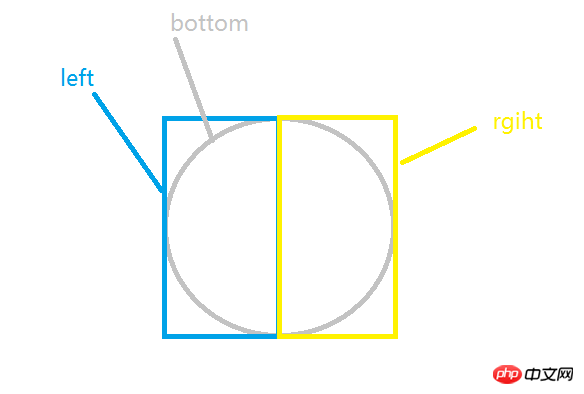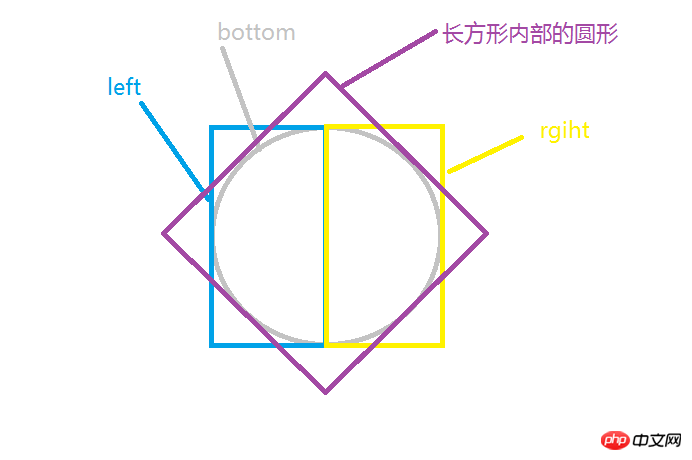
When developing a WeChat applet, I encountered the need for a circularprogress bar. UsingcanvasDrawingis more troublesome:
1. In order to achieve adaptation on different screens, the size of the progress bar must be dynamically calculated;
2. In the applet , canvas has the highest level and is not easy to expand.
But using css3 andjsto implement the progress bar can easily avoid this problem.
Note: This article usesjqueryfor implementation, but the principle is the same. In the mini program, you only need to define and change the correspondingvariables
1. Progress bar style style
In daily development, the border of an element is often used to display a circular pattern. This technique is also used when using CSS3 to implement a circular progress bar. In order to realize the circular border above and dynamically cover the circular border below, a total of one circle, 2 rectangles and 2 semicircles are needed: one circle is used to display the underlying background, and two semicircles are used to cover the underlying background. The background shows the progress, and the other two rectangles are used to cover the progress that does not need to be displayed. As shown below:

The bottombottomcircle is the background of the progress bar. There are two rectangles left and right above the bottom to cover Don't show a progress bar. There is a semicircle inside each of the two rectangles to show progress. Under normal circumstances, a semicircle drawn using a square has an included angle of 45 degrees in diameter and horizontally. In order to make the two semicircles just enough to cover the entire circle, you need to use rotate in CSS3 to rotate the original square to achieve the effect of covering the entire background. As shown in the picture below (for clarity, it is represented by a square here):

As shown in the picture, rotate the semicircle inside the rectangle 45 degrees to the right (clockwise) to get the progress An image that covers the entire background. Rotate the semicircle 135 degrees to the left (counterclockwise) to get an image with only the progress bar background. Why should we rotate to the left instead of all the way to the right? Of course, the effect we want to achieve is: the progress starts from the top and finishes in time. At this point, the idea is very clear. You only need to control the display of progress on the left and right by the percentage.
The html and css code to implement this part is as follows:
html code
css code:
.progressbar{ position: relative; margin: 100px auto; width: 100px; height: 100px; border: 20px solid #ccc; border-radius: 50%; } .left-container,.right-container{ position: absolute; width: 70px; height: 140px; top:-20px; overflow: hidden; z-index: 1; } .left-container{ left: -20px; } .right-container{ right: -20px; } .left-circle,.right-circle{ position: absolute; top:0; width: 100px; height: 100px; border:20px solid transparent; border-radius: 50%; transform: rotate(-135deg); transition: all .5s linear; z-index: 2; } .left-circle{ left: 0; border-top-color: 20px solid blue; border-left-color: 20px solid blue; } .right-circle{ border-right-color: 20px solid blue; border-bottom-color: 20px solid blue; right: 0; }
2: js to control the progress bar
In order to make the logic of the progress bar more robust, the implementation of the js part needs to consider four situations:
1. The basic value and the changed value are on the right side of the progress,
2. The basic value is on the right , the changed value is on the left,
3. The basic value and the changed value are on the left,
4. The basic value is on the left, and the changed value is on the right.
No matter in which case, the core needs to consider only two points: the change of angle and the amount of use time.
In the first case, it is relatively simple, and you can easily calculate the change in angle and the usage time. First, you need to set the time required to change the entire semicircle. After setting, just calculate the time required to change the angle based on the ratio. The code is as follows:
time = (curPercent - oldPercent)/50 * baseTime; //确定时间值为正 curPercent - oldPercent > 0 ? '' : time = - time; deg = curPercent/50*180-135;
The second case is a little more troublesome. Because there is a transition from the progress on the right to the progress on the left. In order to change the progress smoothly, we need to useTimerhere. After changing the right part, modify the left part. The code is as follows:
//设置右边的进度 time = (50 - oldPercent)/50 * baseTime; deg = (50 - oldPercent)/50*180-135; $rightBar .css({ transform: 'rotate('+ deg+ 'deg)', transition : 'all '+ time + 's linear' }) //延时设置左边进度条的改变 setTimeout(function(){ time = (curPercent - 50)/50; deg = (curPercent - 50)/50*180 -135; $leftBar.css({ transform: 'rotate('+ deg+ 'deg)', transition : 'all '+ time + 's linear' }) }, Math.floor(time*1000));000));
The third and fourth situations are similar to the previous situations and will not be discussed here.
The code of the completefunctionthat controls the progress bar is as follows (implemented using jQuery):
/** *设置进度条的变化 *@param {number} oldPercent 进度条改变之前的半分比 *@param {number} curPercent 进度条当前要设置的值 *@return {boolean} 设置成功返回 true,否则,返回fasle */ function setProgessbar(oldPercent, curPercent){ var $leftBar = $('#left-bar'); var $rightBar = $('#right-bar'); //将传入的参数转换,允许字符串表示的数字 oldPercent = + oldPercent; curPercent = + curPercent; //检测参数,如果不是number类型或不在0-100,则不执行 if(typeof oldPercent ==='number' && typeof curPercent ==='number' && oldPercent >= 0 && oldPercent <= 100 && curPercent <= 100 && curPercent >= 0){ var baseTime = 1; //默认改变半圆进度的时间,单位秒 var time = 0; //进度条改变的时间 var deg = 0; //进度条改变的角度 if(oldPercent > 50){//原来进度大于50 if(curPercent>50){ //设置左边的进度 time = (curPercent - oldPercent)/50 * baseTime; //确定时间值为正 curPercent - oldPercent > 0 ? '' : time = - time; deg = curPercent/50*180-135; $leftBar .css({ transform: 'rotate('+ deg+ 'deg)', transition : 'all '+ time + 's linear' }) }else{ //设置左边的进度 time = (oldPercent - 50)/50 * baseTime; deg = (oldPercent - 50)/50*180-135; $leftBar .css({ transform: 'rotate('+ deg+ 'deg)', transition : 'all '+ time + 's linear' }) //延时设置右边进度条的改变 setTimeout(function(){ time = (50 - curPercent)/50; deg = (50 - curPercent)/50*180 -135; $rightBar.css({ transform: 'rotate('+ deg+ 'deg)', transition : 'all '+ time + 's linear' }) }, Math.floor(time*1000)); } }else{//原来进度小于50时 if(curPercent>50){ //设置右边的进度 time = (50 - oldPercent)/50 * baseTime; deg = (50 - oldPercent)/50*180-135; $rightBar .css({ transform: 'rotate('+ deg+ 'deg)', transition : 'all '+ time + 's linear' }) //延时设置左边进度条的改变 setTimeout(function(){ time = (curPercent - 50)/50; deg = (curPercent - 50)/50*180 -135; $leftBar.css({ transform: 'rotate('+ deg+ 'deg)', transition : 'all '+ time + 's linear' }) }, Math.floor(time*1000)); }else{ //设置右边的进度 time = (curPercent - oldPercent)/50 * baseTime; //确定时间值为正 curPercent - oldPercent > 0 ? '' : time = - time; deg = curPercent/50*180-135; $rightBar .css({ transform: 'rotate('+ deg+ 'deg)', transition : 'all '+ time + 's linear' }) } return true; } }else{ return false; } }
When developing the WeChat applet, I encountered the circular progress bar need. Drawing with canvas is more troublesome:
1. In order to achieve adaptation on different screens, the size of the progress bar must be dynamically calculated;
2. In the mini program, the canvas has the highest level , not easy to expand.
But using css3 and js to implement the progress bar can easily avoid this problem.
Note: This article is implemented using jquery, but the principle is the same. In the mini program, just define and change the corresponding variables
The above is the detailed content of Use css3 to implement circular progress bar. For more information, please follow other related articles on the PHP Chinese website!




